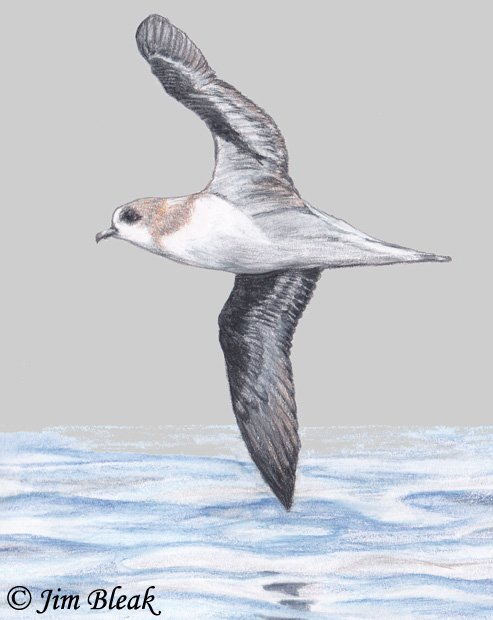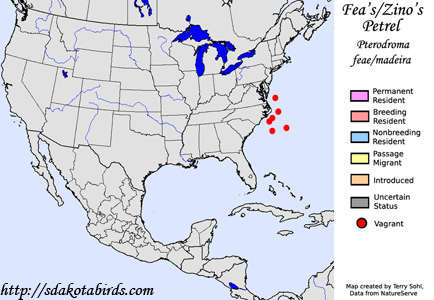| Length: 15 inches | Wingspan: 34 inches | Seasonality: Non-resident in South Dakota |
| ID Keys: Dark upperparts with pale gray tail and coverts, light underbody, dark underwings, head white with darker cap and grayish nape | ||
 Until
recently, the Soft-plumaged Petrel (Pterodroma mollis) was
considered one species with several distinct races. Some groups
recently recognized a split into four distinct species, including the Fea's
Petrel (Pterodroma feae) and the Zino's Petrel (Pterodroma
madeira). The Fea's Petrel and the Zino's Petrel are closely
related, are the American Birding
Association checklist currently lists the two species concurrently.
The Zino's Petrel is endemic to the island of Madeira, an island in the
North Atlantic off the coast of Portugal. There, they are critically
endangered, with a population of just a few hundred at most. The very
similar Fea's Petrel primarily breeds in the Cape Verde Islands (sometimes
they are called the "Cape Verde Petrel"), and while the populations are
stronger, there are several thousand birds worldwide, at most.
Non-breeding birds of both species (sub-species?) wander the Atlantic, and
Fea's Petrels are now known to be rare but semi-regular visitors to the
water's off the Atlantic coast of the United States.
Until
recently, the Soft-plumaged Petrel (Pterodroma mollis) was
considered one species with several distinct races. Some groups
recently recognized a split into four distinct species, including the Fea's
Petrel (Pterodroma feae) and the Zino's Petrel (Pterodroma
madeira). The Fea's Petrel and the Zino's Petrel are closely
related, are the American Birding
Association checklist currently lists the two species concurrently.
The Zino's Petrel is endemic to the island of Madeira, an island in the
North Atlantic off the coast of Portugal. There, they are critically
endangered, with a population of just a few hundred at most. The very
similar Fea's Petrel primarily breeds in the Cape Verde Islands (sometimes
they are called the "Cape Verde Petrel"), and while the populations are
stronger, there are several thousand birds worldwide, at most.
Non-breeding birds of both species (sub-species?) wander the Atlantic, and
Fea's Petrels are now known to be rare but semi-regular visitors to the
water's off the Atlantic coast of the United States.
Habitat: Breeds on islands with high ledges where nesting burrows can be built. Pelagic as non-breeders, ranging widely at sea.
Diet: Feeds on squid and small fish.
Behavior: Feeding is typically done while in flight, with birds dipping down and grabbing prey items when they are spotted. They will also sometimes sit on the ocean's surface and reach down to grab food items while swimming.
Nesting: The nest of the two species is a burrow. They are nocturnal, only active around breeding colonies at night, presumably to avoid predation by gulls and other seabirds. They lay a single egg, with both parents helping to incubate the egg, and helping to raise the young after hatching.
Song: Usually silent away from breeding colonies. At breeding colonies, gives an owl-like hooting and also a soft whining call.
Migration: Very limited breeding ranges for the two species, but non-breeding birds wander widely across the Atlantic.
Interactive eBird Map: Click here to access an interactive eBird map of Fea's/Zinos Petrel sightings
Similar Species: Both these species are very similar to each other. They are also similar to the Deserta's Petrel, another bird formerly considered a race of one conspecific species.
Conservation Status: Breeding ranges of both the Fea's Petrel and the Zino's Petrel are very small, and populations are in danger. Zino's Petrels are considered one of the most endangered species in Europe. The IUCN lists the Fea's Petrel as "Near Threatened", while they list the Zino's Petrel as "Endangered".
Further Information: 1) OceanWanderers.com - Fea's Petrel
2) BirdGuides.com - Fea's Petrel
3) BirdLife.org - Zino's Petrel
Image Information: Watercolor pencil sketch by Jim Bleak - Licensed under Creative Commons Attribution-ShareAlike 3.0 Unported license.
| Click below for a higher-resolution map |
 |
| South Dakota Status: Non-resident in South Dakota. |
Additional Fea's and Zino's Petrel Photos (coming soon!!)
